Why you can trust Tom's Hardware
The Radeon RX 7600 definitely qualifies as a 1080p gaming solution, and not just because AMD says so. Where Nvidia's $399 RTX 4060 Ti seems like it ought to be more of a 1440p card (outside of ray tracing, perhaps), we wouldn't expect a $269 card to primarily target 1440p.
This isn't to say that you can only game at 1080p on the RX 7600. Obviously, less demanding games will run perfectly fine at 1440p, and even 4K in some cases. There will also be super demanding games that won't even run well at 1080p with maxed-out settings. But overall, it makes sense to consider mainstream GPUs as 1080p solutions.
Like Nvidia, AMD points to the Steam Hardware Survey, where 65% of surveyed PCs still have 1080p as their primary monitor's resolution — and another 12% use lower resolutions (probably laptops for a lot of those). Paying less than $300 for a mainstream 1080p gaming GPU sounds much better than paying $400 for the same privilege, even if the Nvidia card is faster.
We'll start with the global look at 1080p performance, using the geometric mean of all 15 games in our test suite. That includes both the ray tracing and rasterization test suites, and you can probably guess that AMD's GPUs will struggle quite a bit with some of the ray tracing games. If you don't care about ray tracing, that's fine as well, and we'll have separate charts looking at just the rasterization performance (nine games) or just the ray tracing performance (six games). We'll also have charts for the individual games.
Some will say our test suite is too heavy on ray tracing games. Perhaps. But those are the most demanding games these days, so if a GPU can handle something like Cyberpunk 2077 at RT-Ultra settings, it's a safe bet it can run just about any other game. Besides, ray tracing has been the holy grail for graphics for decades, and we're coming up on five years since DirectX Raytracing (DXR) was first revealed as the next Microsoft gaming API. So it's useful to see whether modern mainstream solutions are getting to the point where they can handle ray tracing games without choking.


We have two charts, 1080p ultra and 1080p medium. The RX 7600 arguably doesn't fully belong to either of those, but we have to draw the line somewhere. By testing at medium and ultra, you'll at least have a reasonable idea of where high would land: roughly midway between the two. Let's talk about what the overall charts tell us.
First, the RX 7600 doesn't offer a new level of performance. There was a chance it might offer improved performance at a lower price point, but even that doesn't generally hold water. The RX 7600 falls right between the existing RX 6650 XT and the RX 6700 10GB cards, which was already a narrow gap. Based on our testing, the 6700 10GB is about 5% faster than the 6650 XT at 1080p medium, and 10% faster at 1080p ultra. So AMD is basically wedging the RX 7600 between the two, at least until supplies of the previous generation parts disappear.
The RX 7600 also matches or beats the RTX 3060 in overall performance. It's around 5% in our medium tests and tied at 1080p ultra. And the 3060 is still a good card, better in some ways than its future replacement since it has a 192-bit memory interface and 12GB of VRAM, but that's a topic for another day.
We're glad to see that the RX 7600 can at least surpass the RX 6650 XT because when AMD first started telling us about the new GPU, we thought it might come up short. At the same time, the RX 6650 XT now sells for under $250, so getting 4% more performance for 10% more money isn't exactly an awesome bargain. Also, the RX 6700 10GB costs the same $269 and gives you 2GB more VRAM and slightly higher performance; it just doesn't have hardware AV1 encoding.


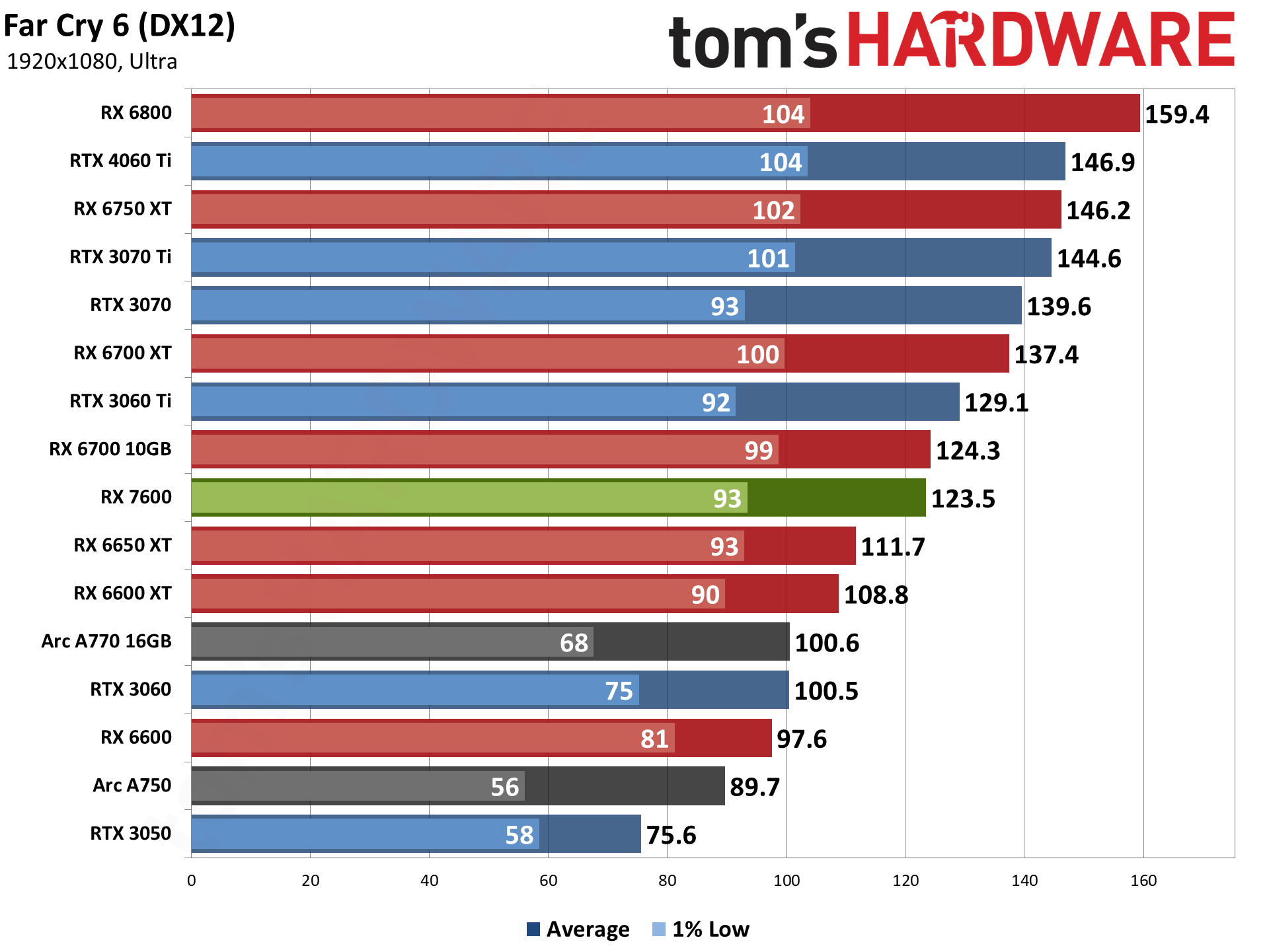
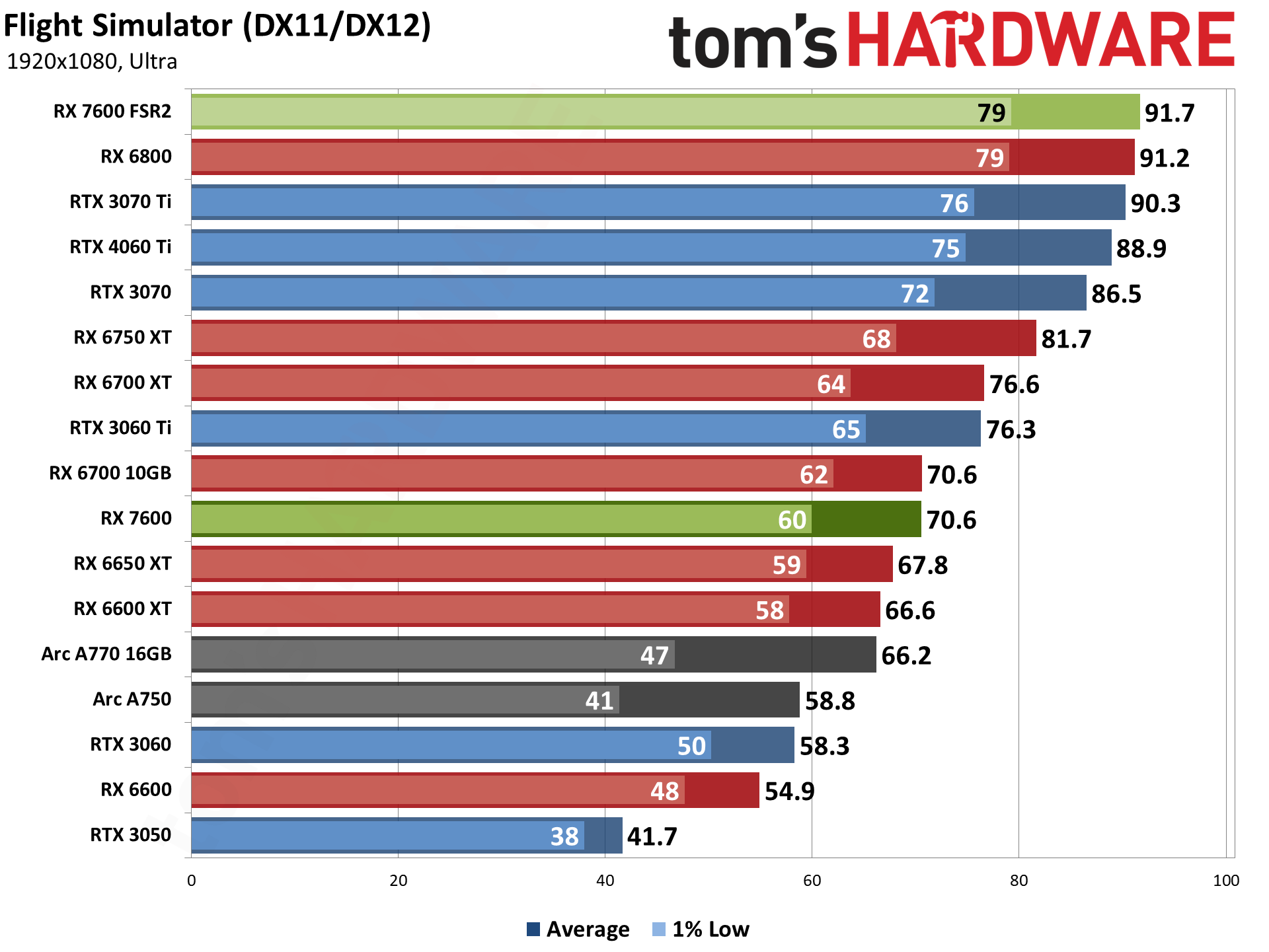
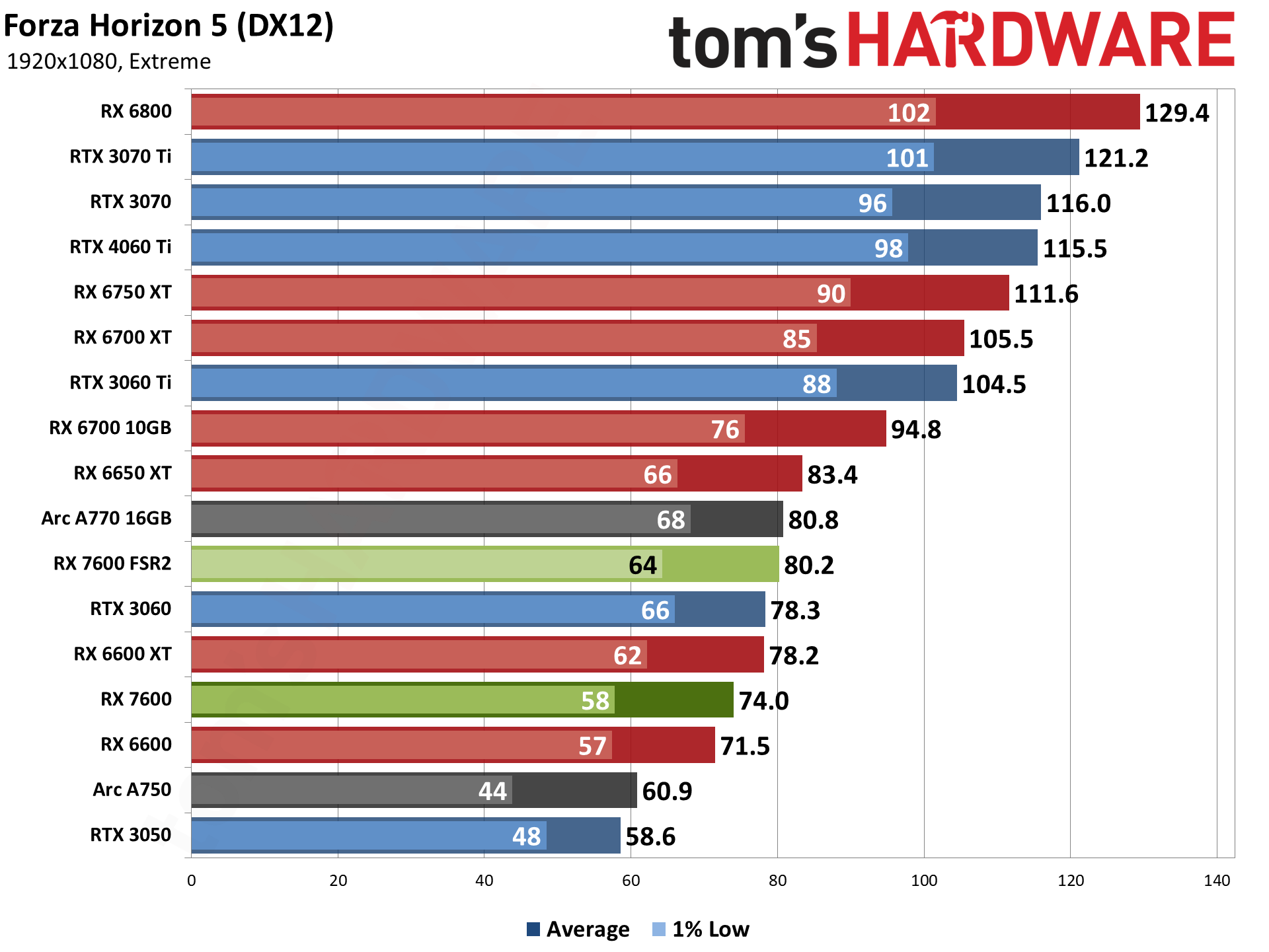





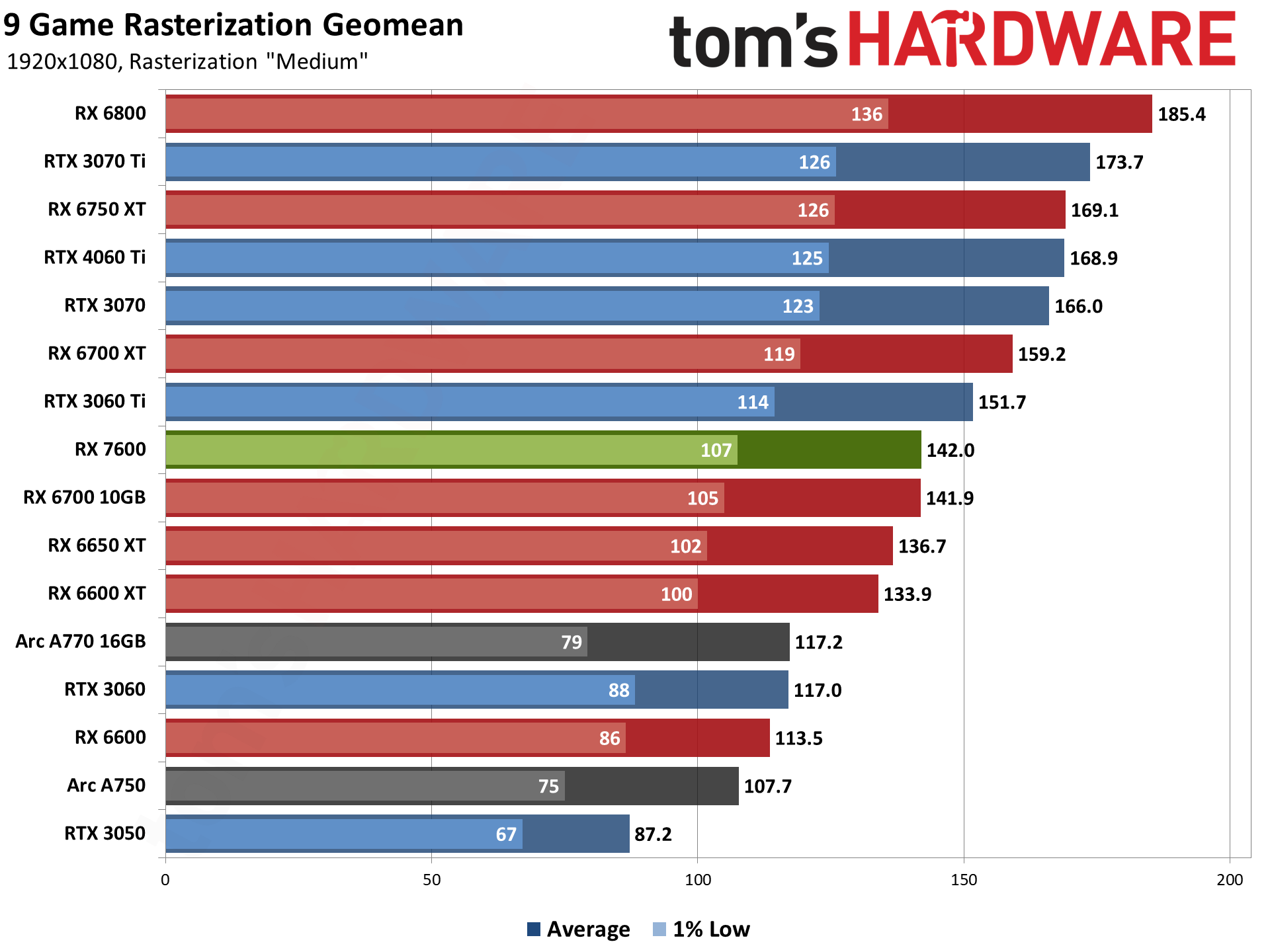



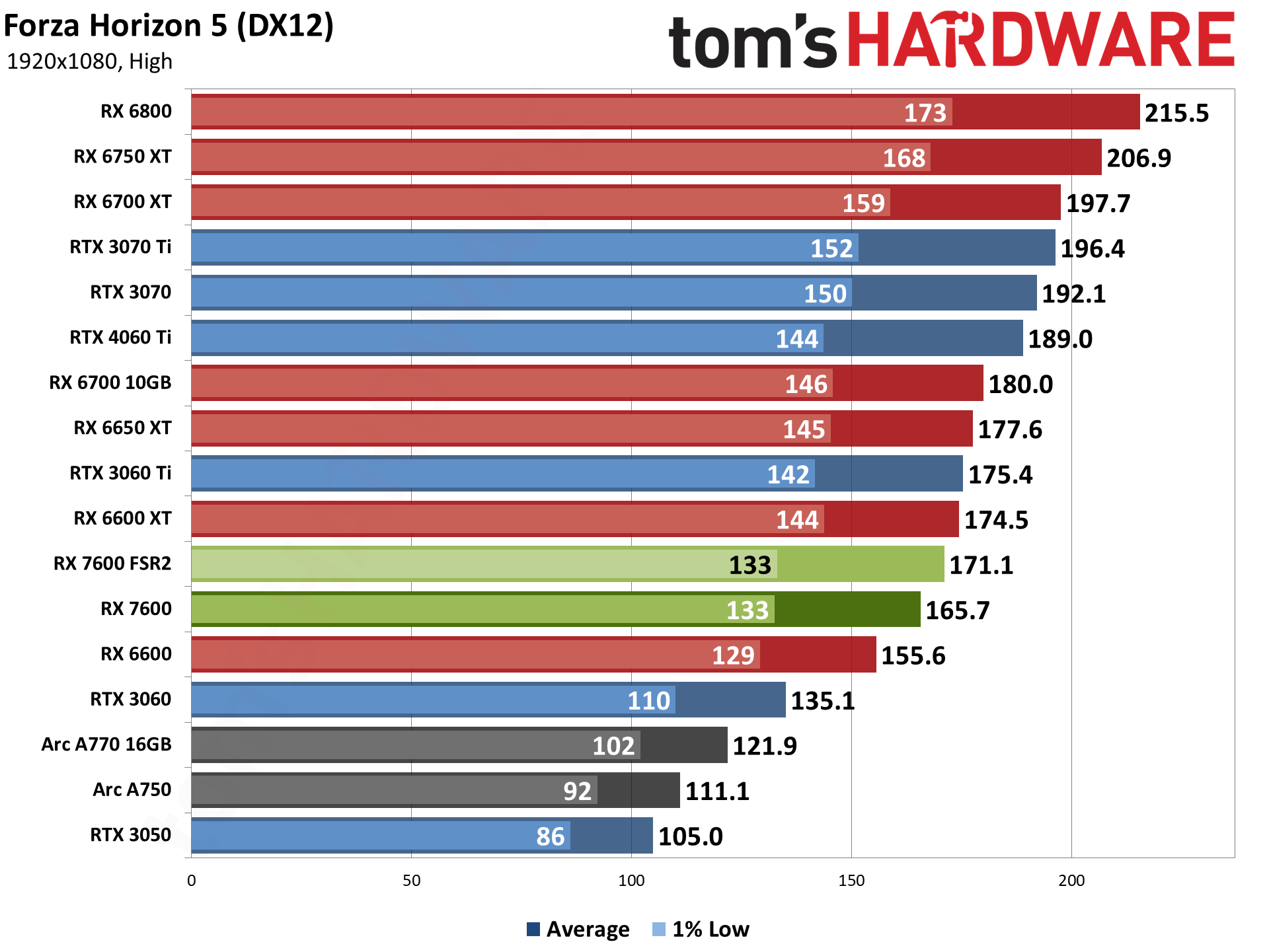





Looking at just rasterization performance, AMD's GPUs move up the charts relative to their Nvidia and Intel competition. The RX 7600 beats the RTX 3060 by 21% at medium settings and 17% at ultra. Interestingly, it also comes out a touch ahead of the RX 6700 at medium settings (though it's basically margin of error). Considering we're using a factory overclocked RX 6650 XT, having a 4% lead with a reference clocked card also means third-party RX 7600 models might widen the gap a bit.
It's still pretty much a tie, though. We normally say that the threshold for truly noticing the difference in performance between graphics cards is around 20%, though some people might be able to register as little as a 10% difference. The RX 7600 versus RX 6650 XT lands way down in the single digits, and only benchmarks will really show which card is (barely) faster.
Across the nine rasterization games, the difference between the RX 7600 and the previous generation RX 6650 XT is anywhere from -11% (Forza Horizon 5) to at most 14% (Total War: Warhammer 3). We just retested those two games last week on the RX 6650 XT running the 23.4.3 drivers, so some of that might simply be the newer drivers on the RX 7600, or perhaps those two games are just more susceptible to the architectural changes with RDNA 3.
Except that doesn't really make sense. We could see a more compute-heavy game (TWW3) being faster, but we don't have a good explanation for why FH5 would be that much slower, other than drivers. Too bad the preview drivers are only for the RX 7600.




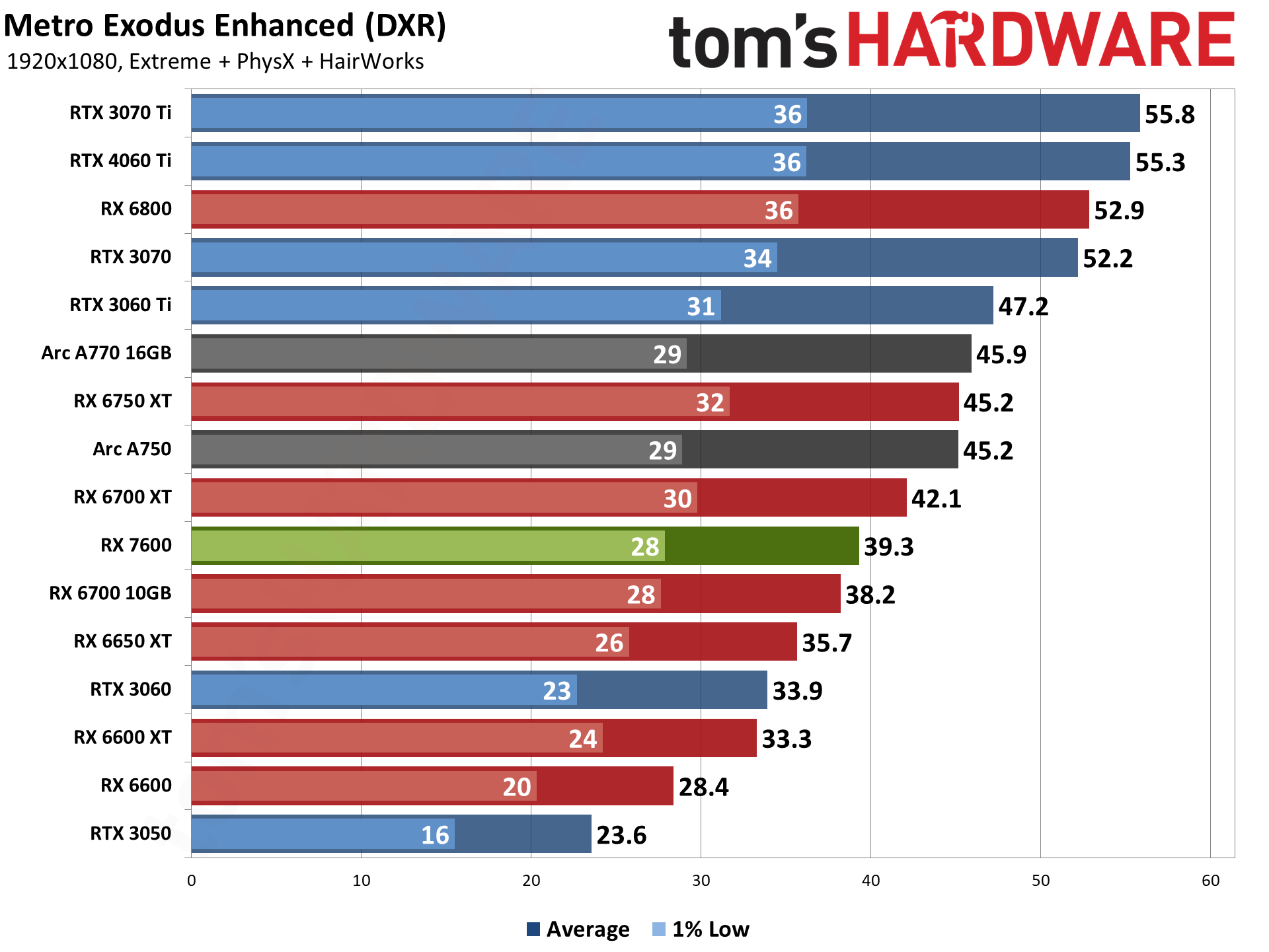






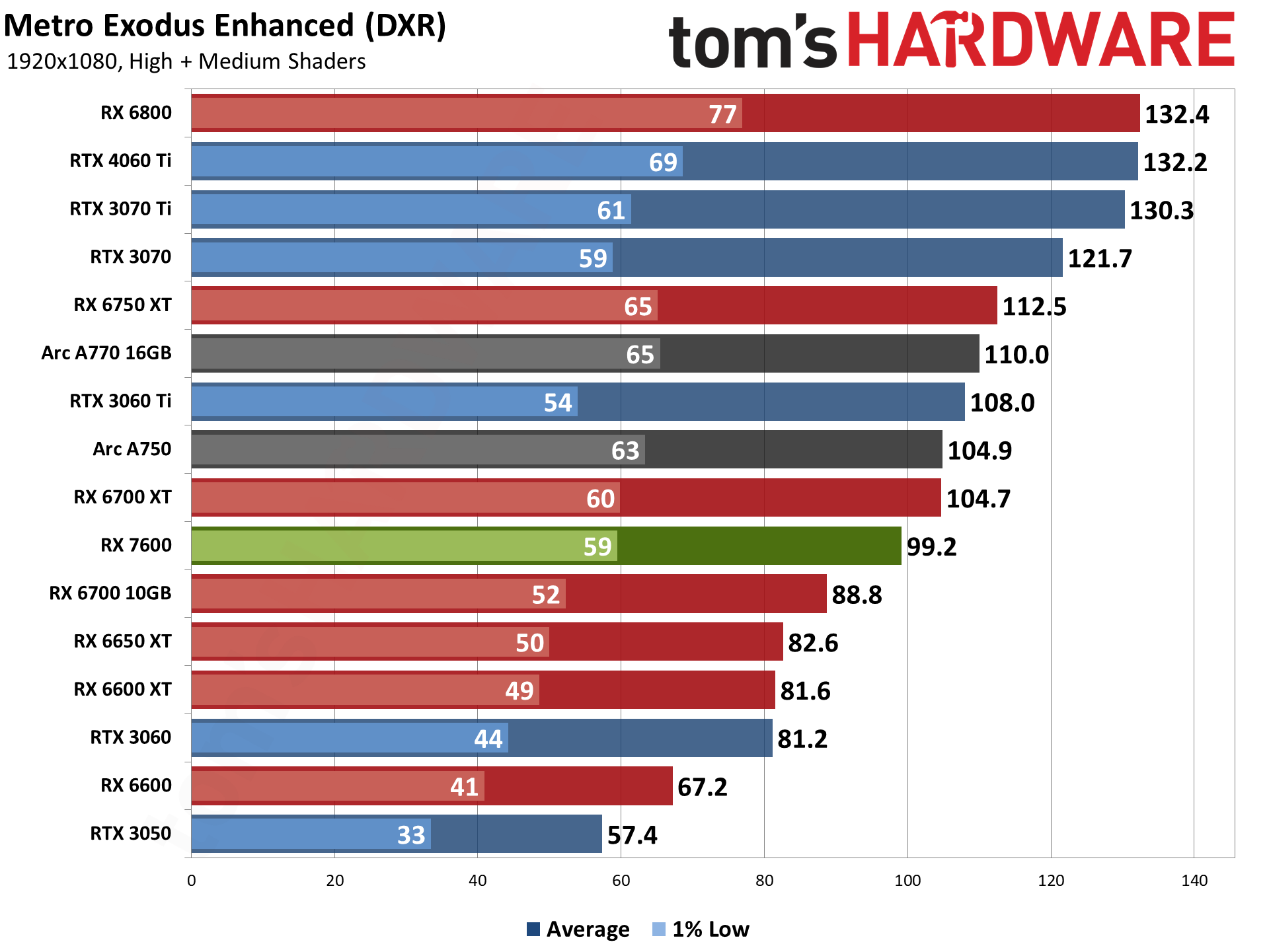


Our ray tracing test suite turns the table on AMD GPUs, and now all of the red bars drop further down the charts. This was expected, though RDNA 3 does have some enhancements that can potentially help it in ray tracing. Looking at the RX 7600 and RX 6650 XT numbers, though, any architectural upgrades relative to ray tracing don't seem to matter much.
We should also note that the current AMD drivers seem to have problems with Control Ultimate Edition. At times, we'll get massive slowdowns and single digit framerates. This has started happening on all AMD GPUs to various degrees, but it was especially noticeable on the RX 7600. We've notified AMD of the problem and it will likely get fixed in a future driver.
Nvidia's RTX 3060 clearly pulls ahead of the RX 7600 in our DXR test suite. VRAM can also be a bigger factor with ray tracing, which explains why the RX 6700 ends up 10% faster at 1080p ultra. But most of the GPUs in our ray tracing charts are striving more for adequate than actually good performance, particularly in the 1080p ultra chart.
At basically maxed out settings, with demanding ray tracing games, the RX 7600 can fall below 30 fps. And if you're wondering, the RX 7600 basically offers the same level of performance (give or take) as a PlayStation 5. If a game were to offer an equivalent to our DXR Ultra settings, it would also struggle to run well on the current generation consoles.
Of the six DXR games we tested, three dropped below 30 fps at 1080p ultra on the RX 7600: Minecraft (a very demanding ray tracing game), Cyberpunk 2077, and the Bright Memory Infinite Benchmark (which is way more graphically intensive than the actual game, but it makes for a demanding benchmark). But if you drop to "medium" RT settings — which sort of defeats the purpose of RT, but whatever — most games will at least be playable.
- MORE: Best Graphics Cards
- MORE: GPU Benchmarks and Hierarchy
- MORE: All Graphics Content
Get Tom's Hardware's best news and in-depth reviews, straight to your inbox.
Current page: Radeon RX 7600: 1080p Gaming Performance
Prev Page AMD RX 6700 Test Setup Next Page Radeon RX 7600: 1440p Gaming Performance
Jarred Walton is a senior editor at Tom's Hardware focusing on everything GPU. He has been working as a tech journalist since 2004, writing for AnandTech, Maximum PC, and PC Gamer. From the first S3 Virge '3D decelerators' to today's GPUs, Jarred keeps up with all the latest graphics trends and is the one to ask about game performance.
-
Amdlova As what I expected another pile of crap. One watt better than the old gen. Why spend sand on these... 199 dollar max for this graphics.Reply
@JarredWaltonGPU thanks for the review... hard time to you trying find somenthing good or new on these graphics -
salgado18 AMD should have made a refresh of the RX 6650 XT and earn more money. If nothing really improved, then what's the point?Reply -
btmedic04 Glad to see the last minute price drop, it definitely makes it a much more appealing product. Currently at newegg there are 5 rx 6650xt models available with an average price of $288 minus an average discount of $20. So more or less the same price as the rx 7600 mba. given that information, if I were in the market at that price range, I'd just grab the 7600 given they are more or less the same price once you factor in discounts. It still would've been nice to see a -600 class part match the last generation -700 class part in performance. Maybe we'll see that with a 7600 xtReply -
InvalidError Reply
While it may not make sense for people who already own something from the last generation or two, plenty of people have 5+ years old GPUs or are building new with no half-decent GPU to spare.Amdlova said:As what I expected another pile of crap. One watt better than the old gen. Why spend sand on these... 199 dollar max for this graphics.
I'm still using a GTX1050, waiting for something decent to hit ~$260 CAN. I bought an open-box A750 for $270 a few weeks ago, ended up returning it as seemingly defective since it caused my PC to crash repeatedly. -
Elusive Ruse Reply
People want a brilliant GPU and they wanna pay $250 for it, as if the whole pandemic, parts shortage and a historic inflation went over their head. This might sound like a radical idea, but mid-range starts at $500 now. :LOL:InvalidError said:While it may not make sense for people who already own something from the last generation or two, plenty of people have 5+ years old GPUs or are building new with no half-decent GPU to spare.
I'm still using a GTX1050, waiting for something decent to hit ~$260 CAN. I bought an open-box A750 for $270 a few weeks ago, ended up returning it as seemingly defective since it caused my PC to crash repeatedly. -
atomicWAR Reply
Should it though?Elusive Ruse said:This might sound like a radical idea, but mid-range starts at $500 now. :LOL:
